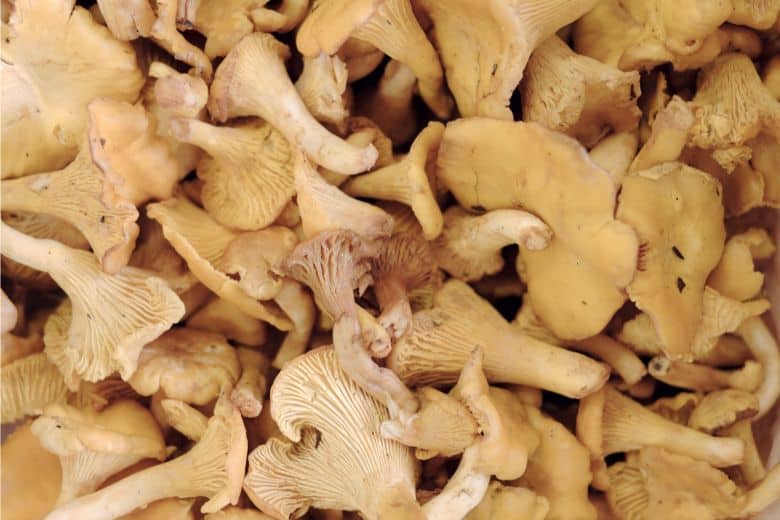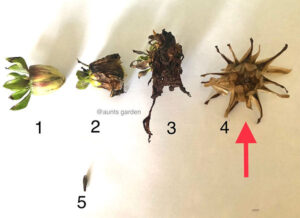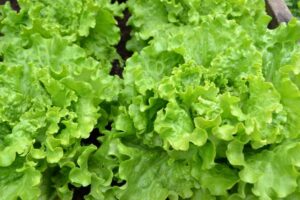
Chanterelle mushrooms, scientifically known as Cantharellus cibarius, are highly sought after in culinary circles due to their distinct flavor and high nutritional content. These golden beauties often grow in the wild, flourishing in damp, forested areas. They have a unique, funnel-like shape, a vibrant orange color, and a fruity aroma reminiscent of apricots.
While they’re not typically grown in a home setting, it’s not impossible. With the right conditions and a bit of patience, learning how to grow chanterelle mushrooms at home can become a rewarding hobby.
This detailed guide will take you through the whole process of cultivating these golden delicacies in your backyard or indoor garden.
Understanding the Chanterelle Mushroom
Before we delve into the growing process, let’s explore the Chanterelle mushroom, or Cantharellus cibarius. Chanterelles are distinguished by their vibrant golden-yellow hue, trumpet-shaped cap, and unique apricot-like aroma. They thrive in the wild, often forming symbiotic relationships with certain trees such as oaks, birches, and pines.
Chanterelle Mushroom Life Cycle
Just like any other plant or fungi, chanterelles have a specific life cycle. They start as spores, develop into mycelium, which forms a symbiotic relationship with tree roots, and then fruit into the mushroom we recognize. Understanding this life cycle is critical for successful cultivation.
Ideal Environment for Chanterelle Growth
Chanterelles thrive in a specific environment, one that is damp, cool, and rich in organic material. They also prefer slightly acidic soil and have a strong preference for certain types of trees. If you’re serious about growing these mushrooms, you’ll need to recreate this environment as closely as possible.
Why Grow Chanterelle Mushrooms?
Let’s understand why chanterelles are worth the gardening effort.
- Nutritional Benefits: Chanterelles are packed with vitamins and minerals, including Vitamin D, Vitamin C, and potassium. They also contain good amounts of dietary fiber and protein. In addition to their delicious taste, they’re a nutritious addition to any meal.
- Culinary Uses: Known for their nutty flavor and firm texture, chanterelles are used in a variety of dishes, from sautéed sides to gourmet stews and sauces. They can elevate any recipe, adding a touch of luxury to your meals.
Necessary Materials for Cultivating Chanterelle Mushrooms
Growing these magical mushrooms at home can be a bit tricky, but with the right tools and some patience, you can cultivate your very own crop. Here are the essentials you need:
- Chanterelle mushroom spores: These can be bought from a reputable supplier or harvested from wild Chanterelles.
- Substrate: A mixture of hardwood chips, compost, and sand, mimicking the forest floor, works well for Chanterelles.
- A suitable location: Chanterelles need a shaded spot outdoors, preferably under hardwood trees, or a carefully controlled indoor environment.
Steps to Grow Chanterelle Mushrooms at Home
Here’s a step-by-step guide on how to grow Chanterelle mushrooms at home.
Step 1: Preparing the Substrate
Start by mixing hardwood chips, compost, and sand in equal proportions. This mimics the Chanterelles’ natural habitat, creating a conducive environment for the spores to germinate and grow.
Step 2: Sowing the Spores
Sprinkle the Chanterelle mushroom spores evenly across the prepared substrate. Lightly mix them in so that they’re not too deep.
Step 3: Caring for the Growing Medium
Water the substrate regularly to keep it moist but not waterlogged. Also, maintain a temperature between 65°F and 75°F. Chanterelles also require high humidity, around 80-90%.
Step 4: Watching for Growth
The growth process can be slow and requires patience. Over several weeks, you should start seeing a mycelial network forming – a clear sign that your Chanterelle mushrooms are growing!
Step 5: Harvesting Your Chanterelle Mushrooms
Once the mushrooms reach the desired size, gently twist and pull them out from the substrate. Make sure to leave some behind to continue the growth cycle.
Step 6: Maintenance and Care
Keep the substrate moist but not waterlogged. Also, try to maintain a consistent temperature similar to their natural environment (around 60-70 degrees Fahrenheit).
Common Challenges in Growing Chanterelle Mushrooms and How to Overcome Them
While growing Chanterelle mushrooms at home can be rewarding, it can also present some challenges. However, let’s explore some of the common challenges faced while attempting to grow chanterelle mushrooms and potential strategies that could be used to overcome them.
Challenges 1: Symbiotic Relationship with Trees
Chanterelle mushrooms have a mycorrhizal relationship with certain types of trees, which means the mushrooms and trees share nutrients with each other. This relationship is quite complex and is difficult to replicate outside of the natural environment.
Solution:
If you’re attempting to grow chanterelle mushrooms, you may need to mimic their natural habitat as closely as possible. This could involve growing them in an area with the same type of trees they naturally grow near. For chanterelles, this often includes oaks, beeches, and conifers.
Challenges 2: Environmental Conditions:
Chanterelles require very specific environmental conditions to grow, including the right temperature, humidity, soil acidity, and light levels. They also prefer well-drained soil that is rich in organic matter.
Solution:
You should try to reproduce these conditions as closely as possible. This might include controlling the temperature and humidity in a greenhouse or shade house, using specific soil mixtures, and providing the right amount of light.
Challenges 3: Slow Growth:
Chanterelles grow slower than many other types of mushrooms. This can be frustrating for those who want to see results quickly.
Solution:
Patience is key when it comes to growing chanterelles. You’ll also want to ensure that they have all the nutrients they need and that they’re not being crowded out by other types of fungi.
Challenges 4: Difficulty in Spore Germination:
Chanterelle spores can be hard to germinate, and even when they do, it’s not guaranteed that a mushroom will form.
Solution:
To help the spores germinate, you might need to provide them with a nutrient-rich growing medium and the correct environmental conditions. This is a delicate process that requires attention to detail and a lot of patience.
Challenges 5: Disease and Pest Management:
Like any crop, chanterelles are susceptible to various pests and diseases. They can be affected by a variety of fungal diseases, and they can also be eaten by slugs and other pests.
Solution:
You will need to keep a close eye on your growing area and be ready to take action if you notice any signs of disease or pest activity. This could involve using organic pesticides or other methods of pest control.
Note: For the most part, these delicious mushrooms are foraged from their natural habitats. If you decide to forage for them yourself, remember to only take what you will use, leave the smallest mushrooms behind, and tread lightly to protect these precious ecosystems.
Frequently Asked Questions
Can chanterelle mushrooms grow in any type of soil?
Answer: Chanterelles prefer well-drained soil, often found in hardwood forests. They don’t grow well in sandy or clay soils.
How long does it take to grow chanterelle mushrooms?
Answer: Chanterelle mushrooms can take anywhere from a few weeks to several months to grow, depending on the conditions. Patience is key when growing these mushrooms.
What’s the best time of year to plant chanterelle spores?
Answer: Spring is often considered the best time to plant chanterelle spores. This gives them ample time to establish before the colder months set in.
What’s the best way to store fresh chanterelle mushrooms?
Answer: Chanterelle mushrooms should be stored in a paper bag in the refrigerator. This allows them to breathe while keeping them cool, helping to preserve their freshness.
Is it safe to eat raw chanterelle mushrooms?
Answer: While it’s generally safe to eat raw chanterelle mushrooms, cooking them helps to release their flavors and makes them easier to digest.
Conclusion
Cultivating chanterelle mushrooms requires patience and a bit of know-how, but the reward of harvesting your own gourmet mushrooms is well worth it. Whether you’re a home cook looking to elevate your meals or a nature enthusiast wanting to bring a bit of the forest home, growing chanterelles can be a rewarding experience.







